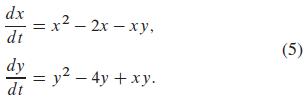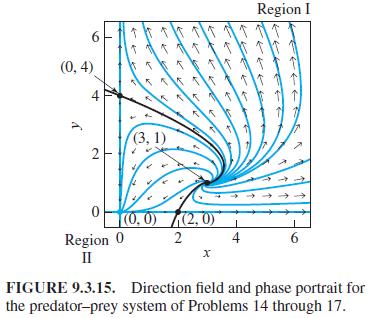Problems 14 through 17 deal with the predatorprey system Here each population-the prey population x(t) and the
Question:
Problems 14 through 17 deal with the predator–prey system

Here each population-the prey population x(t) and the predator population y(t)-is an unsophisticated population (like the alligators of Section 2.1) for which the only alternatives (in the absence of the other population) are doomsday and extinction. Problems 14 through 17 imply that the four critical points (0,0), (0,4), (2,0), and (3, 1) of the system in (5) are as shown in Fig. 9.3.15-a nodal sink at the origin, a saddle point on each coordinate axis, and a spiral source interior to the first quadrant. This is a two-dimensional version of "doomsday versus extinction." If the initial point (x0, y0) lies in Region I, then both populations increase without bound (until doomsday), whereas if it lies in Region II, then both populations decrease to zero (and thus both become extinct). In each of these problems use a graphing calculator or computer system to construct a phase plane portrait for the linearization at the indicated critical point. Do your local portraits look consistent with Fig. 9.3.15?

Show that the linearization of (5) at (2, 0) is u' = 2u - 2v, v' = -2v. Then show that the coefficient matrix of this linear system has the positive eigenvalue λ1 = 2 and the negative eigenvalue λ2 = -2. Hence (2,0) is a saddle point for the system in (5).
Step by Step Answer:

Differential Equations And Linear Algebra
ISBN: 9780134497181
4th Edition
Authors: C. Edwards, David Penney, David Calvis





